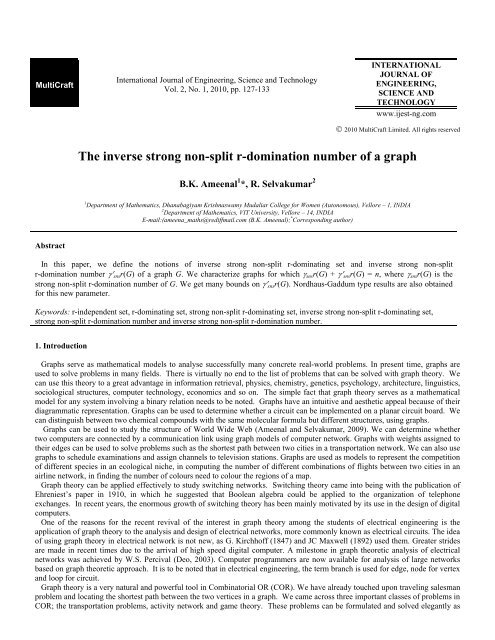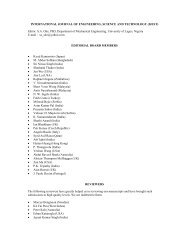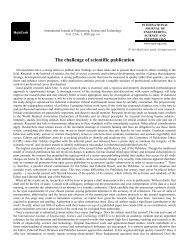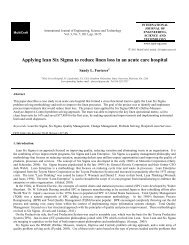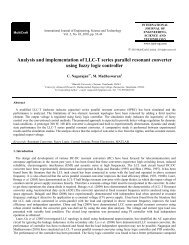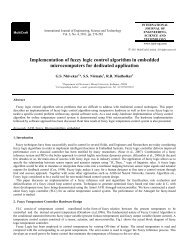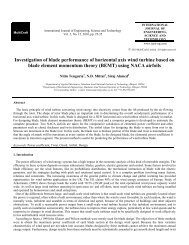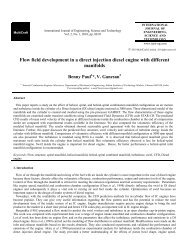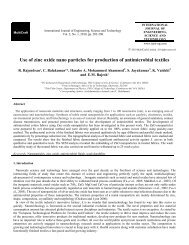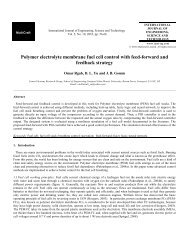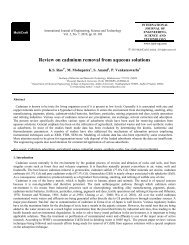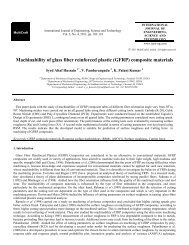The inverse strong non-split r-domination number of a graph
The inverse strong non-split r-domination number of a graph
The inverse strong non-split r-domination number of a graph
Create successful ePaper yourself
Turn your PDF publications into a flip-book with our unique Google optimized e-Paper software.
MultiCraft<br />
International Journal <strong>of</strong> Engineering, Science and Technology<br />
Vol. 2, No. 1, 2010, pp. 127-133<br />
INTERNATIONAL<br />
JOURNAL OF<br />
ENGINEERING,<br />
SCIENCE AND<br />
TECHNOLOGY<br />
www.ijest-ng.com<br />
© 2010 MultiCraft Limited. All rights reserved<br />
<<strong>strong</strong>>The</<strong>strong</strong>> <<strong>strong</strong>>inverse</<strong>strong</strong>> <strong>strong</strong> <strong>non</strong>-<strong>split</strong> r-<strong>domination</strong> <strong>number</strong> <strong>of</strong> a <strong>graph</strong><br />
B.K. Ameenal 1 *, R. Selvakumar 2<br />
1 Department <strong>of</strong> Mathematics, Dhanabagiyam Krishnaswamy Mudaliar College for Women (Autonomous), Vellore – 1, INDIA<br />
2 Department <strong>of</strong> Mathematics, VIT University, Vellore – 14, INDIA<br />
E-mail:(ameena_maths@rediffmail.com (B.K. Ameenal); * Corresponding author)<br />
Abstract<br />
In this paper, we define the notions <strong>of</strong> <<strong>strong</strong>>inverse</<strong>strong</strong>> <strong>strong</strong> <strong>non</strong>-<strong>split</strong> r-dominating set and <<strong>strong</strong>>inverse</<strong>strong</strong>> <strong>strong</strong> <strong>non</strong>-<strong>split</strong><br />
r-<strong>domination</strong> <strong>number</strong> γ′ sns r(G) <strong>of</strong> a <strong>graph</strong> G. We characterize <strong>graph</strong>s for which γ sns r(G) + γ′ sns r(G) = n, where γ sns r(G) is the<br />
<strong>strong</strong> <strong>non</strong>-<strong>split</strong> r-<strong>domination</strong> <strong>number</strong> <strong>of</strong> G. We get many bounds on γ′ sns r(G). Nordhaus-Gaddum type results are also obtained<br />
for this new parameter.<br />
Keywords: r-independent set, r-dominating set, <strong>strong</strong> <strong>non</strong>-<strong>split</strong> r-dominating set, <<strong>strong</strong>>inverse</<strong>strong</strong>> <strong>strong</strong> <strong>non</strong>-<strong>split</strong> r-dominating set,<br />
<strong>strong</strong> <strong>non</strong>-<strong>split</strong> r-<strong>domination</strong> <strong>number</strong> and <<strong>strong</strong>>inverse</<strong>strong</strong>> <strong>strong</strong> <strong>non</strong>-<strong>split</strong> r-<strong>domination</strong> <strong>number</strong>.<br />
1. Introduction<br />
Graphs serve as mathematical models to analyse successfully many concrete real-world problems. In present time, <strong>graph</strong>s are<br />
used to solve problems in many fields. <<strong>strong</strong>>The</<strong>strong</strong>>re is virtually no end to the list <strong>of</strong> problems that can be solved with <strong>graph</strong> theory. We<br />
can use this theory to a great advantage in information retrieval, physics, chemistry, genetics, psychology, architecture, linguistics,<br />
sociological structures, computer technology, economics and so on. <<strong>strong</strong>>The</<strong>strong</strong>> simple fact that <strong>graph</strong> theory serves as a mathematical<br />
model for any system involving a binary relation needs to be noted. Graphs have an intuitive and aesthetic appeal because <strong>of</strong> their<br />
diagrammatic representation. Graphs can be used to determine whether a circuit can be implemented on a planar circuit board. We<br />
can distinguish between two chemical compounds with the same molecular formula but different structures, using <strong>graph</strong>s.<br />
Graphs can be used to study the structure <strong>of</strong> World Wide Web (Ameenal and Selvakumar, 2009). We can determine whether<br />
two computers are connected by a communication link using <strong>graph</strong> models <strong>of</strong> computer network. Graphs with weights assigned to<br />
their edges can be used to solve problems such as the shortest path between two cities in a transportation network. We can also use<br />
<strong>graph</strong>s to schedule examinations and assign channels to television stations. Graphs are used as models to represent the competition<br />
<strong>of</strong> different species in an ecological niche, in computing the <strong>number</strong> <strong>of</strong> different combinations <strong>of</strong> flights between two cities in an<br />
airline network, in finding the <strong>number</strong> <strong>of</strong> colours need to colour the regions <strong>of</strong> a map.<br />
Graph theory can be applied effectively to study switching networks. Switching theory came into being with the publication <strong>of</strong><br />
Ehreniest’s paper in 1910, in which he suggested that Boolean algebra could be applied to the organization <strong>of</strong> telephone<br />
exchanges. In recent years, the enormous growth <strong>of</strong> switching theory has been mainly motivated by its use in the design <strong>of</strong> digital<br />
computers.<br />
One <strong>of</strong> the reasons for the recent revival <strong>of</strong> the interest in <strong>graph</strong> theory among the students <strong>of</strong> electrical engineering is the<br />
application <strong>of</strong> <strong>graph</strong> theory to the analysis and design <strong>of</strong> electrical networks, more commonly known as electrical circuits. <<strong>strong</strong>>The</<strong>strong</strong>> idea<br />
<strong>of</strong> using <strong>graph</strong> theory in electrical network is not new, as G. Kirchh<strong>of</strong>f (1847) and JC Maxwell (1892) used them. Greater strides<br />
are made in recent times due to the arrival <strong>of</strong> high speed digital computer. A milestone in <strong>graph</strong> theoretic analysis <strong>of</strong> electrical<br />
networks was achieved by W.S. Percival (Deo, 2003). Computer programmers are now available for analysis <strong>of</strong> large networks<br />
based on <strong>graph</strong> theoretic approach. It is to be noted that in electrical engineering, the term branch is used for edge, node for vertex<br />
and loop for circuit.<br />
Graph theory is a very natural and powerful tool in Combinatorial OR (COR). We have already touched upon traveling salesman<br />
problem and locating the shortest path between the two vertices in a <strong>graph</strong>. We came across three important classes <strong>of</strong> problems in<br />
COR; the transportation problems, activity network and game theory. <<strong>strong</strong>>The</<strong>strong</strong>>se problems can be formulated and solved elegantly as
128<br />
Ammeenal and Selvakumar / International Journal <strong>of</strong> Engineering, Science and Technology,<br />
Vol. 2, No. 1, 2010, pp. 127-133<br />
<strong>graph</strong> theory problems involving, connected and weighted di<strong>graph</strong>s. From a practical point <strong>of</strong> view, all these problems are trivial<br />
if the network is small. Many real life situations however consist <strong>of</strong> huge networks and therefore it is important to look at these<br />
network problems in terms <strong>of</strong> solving them using computers.<br />
<<strong>strong</strong>>The</<strong>strong</strong>>re are more than 75 models <strong>of</strong> dominating and relative types <strong>of</strong> sets in <strong>graph</strong>s, which have appeared in the research literature<br />
for the past 30 years (Haynes et al., 1998a,b). Many <strong>domination</strong> parameters are formed by combining <strong>domination</strong> with another<br />
<strong>graph</strong> theoretic property P. In an attempt to formalize the concept, Haynes et al. defined the conditional <strong>domination</strong> <strong>number</strong> γ(G:P)<br />
as the smallest cardinality <strong>of</strong> a dominating set D⊆V such that the induced sub<strong>graph</strong> satisfies the property P.<br />
Some <strong>of</strong> them are:<br />
P 1 : has no edges<br />
P 2 : has no isolated vertices<br />
P 3 : is connected<br />
P 4 : is independent<br />
P 5 : has a Hamiltonian cycle and so on. Clearly γ(G) ≤ γ(G:P) for any property. Note that with the exemption <strong>of</strong><br />
independent <strong>domination</strong>, these conditional <strong>domination</strong> parameters do not exist for all <strong>graph</strong>s. Any undefined term in this paper<br />
may be found in Haynes et al. (1998).<br />
Cockayne and Hedetniemi (1977) introduced total <strong>domination</strong> in <strong>graph</strong>s. Sampathkumar and Walikar (1979) introduced the<br />
concept <strong>of</strong> connected <strong>domination</strong> in <strong>graph</strong>s. A set D <strong>of</strong> vertices in a <strong>graph</strong> G = (V,E) is called a dominating set if every vertex in<br />
V-D is adjacent to some vertex in D. <<strong>strong</strong>>The</<strong>strong</strong>> dominating set D ⊆ V is a total dominating set if the induced sub<strong>graph</strong> has no<br />
isolated vertices. <<strong>strong</strong>>The</<strong>strong</strong>> dominating set D ⊆ V is a connected dominating set if the induced sub<strong>graph</strong> is connected. <<strong>strong</strong>>The</<strong>strong</strong>><br />
connected <strong>domination</strong> <strong>number</strong> γ c (G) is the minimum cardinality <strong>of</strong> a connected dominating set. Kulli and Janakiram (1997, 2000)<br />
introduced the concept <strong>of</strong> <strong>split</strong> and <strong>non</strong>-<strong>split</strong> <strong>domination</strong> in <strong>graph</strong>s. A dominating set D ⊆ V <strong>of</strong> a <strong>graph</strong> G is a <strong>split</strong> (<strong>non</strong>-<strong>split</strong>)<br />
dominating set if the induced sub<strong>graph</strong> is disconnected (connected). <<strong>strong</strong>>The</<strong>strong</strong>> <strong>split</strong> (<strong>non</strong>-<strong>split</strong>) <strong>domination</strong> <strong>number</strong> γ s (G) (γ ns (G))<br />
is the minimum cardinality <strong>of</strong> a <strong>split</strong> (<strong>non</strong>-<strong>split</strong>) dominating set. Ameenal and Selvakumar (2008) introduced the concept <strong>of</strong><br />
Inverse <strong>split</strong> and <strong>non</strong>-<strong>split</strong> <strong>domination</strong> <strong>number</strong>s in <strong>graph</strong>s. Let D′ be the minimum Inverse dominating set <strong>of</strong> G w.r.to. D. <<strong>strong</strong>>The</<strong>strong</strong>>n D′<br />
is called an Inverse <strong>split</strong> (<strong>non</strong>-<strong>split</strong>) dominating set <strong>of</strong> G if the induced sub<strong>graph</strong> is disconnected (connected). <<strong>strong</strong>>The</<strong>strong</strong>> <<strong>strong</strong>>inverse</<strong>strong</strong>><br />
<strong>split</strong> (<strong>non</strong>-<strong>split</strong>) <strong>domination</strong> <strong>number</strong> is denoted by γ s ′(G) (γ′ ns (G)) and it is the minimum cardinality taken over all the minimal<br />
<<strong>strong</strong>>inverse</<strong>strong</strong>> <strong>split</strong> (<strong>non</strong>-<strong>split</strong>) dominating sets <strong>of</strong> G.<br />
Let G = (V, E) be a finite, connected and undirected <strong>graph</strong> without loops or multiple edges. Let r be a positive integer. A<br />
<strong>non</strong>-empty subset D ⊆ V is a r-dominating set if every vertex in V-D is within a distance r from atleast one vertex <strong>of</strong> D. <<strong>strong</strong>>The</<strong>strong</strong>><br />
r-<strong>domination</strong> <strong>number</strong> γ r (G) is the minimum cardinality taken over all the minimal r-dominating sets <strong>of</strong> G. A r-dominating set<br />
D ⊆ V is said to be <strong>non</strong>-<strong>split</strong> r-dominating set if the induced sub<strong>graph</strong> is connected. <<strong>strong</strong>>The</<strong>strong</strong>> <strong>non</strong>-<strong>split</strong> r-<strong>domination</strong> <strong>number</strong><br />
γ ns r(G) is the smallest cardinality <strong>of</strong> a <strong>non</strong>-<strong>split</strong> r-dominating set <strong>of</strong> G. A <strong>non</strong>-<strong>split</strong> r-dominating set is said to be a <strong>strong</strong> <strong>non</strong>-<strong>split</strong><br />
r-dominating set if the induced sub<strong>graph</strong> is r-complete. <<strong>strong</strong>>The</<strong>strong</strong>> <strong>strong</strong> <strong>non</strong>-<strong>split</strong> r-dominating <strong>number</strong> γ sns r(G) is the minimum<br />
cardinality <strong>of</strong> the <strong>strong</strong> <strong>non</strong>-<strong>split</strong> r-dominating set <strong>of</strong> G. Let D be the minimum r-dominating set <strong>of</strong> G. If V-D contains a<br />
r-dominating set D′ then D′ is called an Inverse r-dominating set <strong>of</strong> G.<br />
Kulli and Sigarkanti (1991) introduced <<strong>strong</strong>>inverse</<strong>strong</strong>> <strong>domination</strong> in <strong>graph</strong>s. Whenever D is a dominating set, V-D is also a dominating<br />
set. Let D be the minimum dominating set <strong>of</strong> G. If V-D contains a dominating set D′ then D′ is called an Inverse dominating set <strong>of</strong><br />
G with respect to D. In this paper, we define the Inverse <strong>strong</strong> <strong>non</strong>-<strong>split</strong> r-dominating set and the Inverse <strong>strong</strong> <strong>non</strong>-<strong>split</strong> r-<br />
<strong>domination</strong> <strong>number</strong> <strong>of</strong> a <strong>graph</strong>. <<strong>strong</strong>>The</<strong>strong</strong>> r-dominating set D′ is called the Inverse <strong>strong</strong> <strong>non</strong>-<strong>split</strong> r-dominating set if the induced<br />
sub<strong>graph</strong> is connected and r-complete. <<strong>strong</strong>>The</<strong>strong</strong>> Inverse <strong>strong</strong> <strong>non</strong>-<strong>split</strong> r-<strong>domination</strong> <strong>number</strong> (denoted by γ′ sns r(G)) is the<br />
cardinality <strong>of</strong> the smallest <<strong>strong</strong>>inverse</<strong>strong</strong>> <strong>strong</strong> <strong>non</strong>-<strong>split</strong> r-dominating set <strong>of</strong> G. In this paper, we characterize <strong>graph</strong>s for which γ sns r(G) +<br />
γ′ sns r(G) = n. We get many bounds on γ′ sns r(G). Nordhaus-Gaddum type results are also obtained for this new parameter.<br />
Kulli and Janakiram (2003) also introduced the concept <strong>of</strong> <strong>strong</strong> <strong>non</strong>-<strong>split</strong> <strong>domination</strong> <strong>number</strong> in <strong>graph</strong>s. A dominating set D<br />
<strong>of</strong> a Graph is a <strong>strong</strong> <strong>non</strong>-<strong>split</strong> dominating set, if the induced sub<strong>graph</strong> is complete and connected. <<strong>strong</strong>>The</<strong>strong</strong>> <strong>strong</strong> <strong>non</strong>-<strong>split</strong><br />
<strong>domination</strong> numger is denoted by γ sns (G) and it is the minimum cardinality <strong>of</strong> a <strong>strong</strong> <strong>non</strong>-<strong>split</strong> dominating set.<br />
Timothy et al. (1994) introduced the concept <strong>of</strong> distance <strong>domination</strong>. When distance <strong>domination</strong> is introduced, the elements <strong>of</strong><br />
the complement <strong>of</strong> a dominating set need not have direct links with elements <strong>of</strong> the dominating set. Even if the elements are at<br />
some distance from the elements <strong>of</strong> a dominating set, the communication may be still possible. For example, when using radio<br />
frequencies, one can sent the communication to the recipients within the range <strong>of</strong> certain radius. <<strong>strong</strong>>The</<strong>strong</strong>> idea <strong>of</strong> r-<strong>domination</strong> demands<br />
that there should be atleast one person in the dominating set at a distance less than or equal to r from any given person in the<br />
complement. To manage situations <strong>of</strong> impossible Fault – tolerance in the dominating sets, we impose conditions that the<br />
complement <strong>of</strong> the dominating set is intact. That is, the communication from one element <strong>of</strong> the complement to another may not<br />
take more time. In other words, the complement is connected and the maximum distance between any two elements is also less<br />
than or equal to r. For Graph preliminaries, we referred to Ore (1962) and Chartrand and Lesniak (1996). For the properties <strong>of</strong><br />
complementary <strong>graph</strong>s, we referred to Chartrand and Schuster (1974).
129<br />
Ammeenal and Selvakumar / International Journal <strong>of</strong> Engineering, Science and Technology,<br />
Vol. 2, No. 1, 2010, pp. 127-133<br />
1.1 Note<br />
<<strong>strong</strong>>The</<strong>strong</strong>> distance between any two vertices u, v ∈ V(G) is the length <strong>of</strong> the shortest path joining them and it is denoted by d(u,v). <<strong>strong</strong>>The</<strong>strong</strong>><br />
diameter <strong>of</strong> a <strong>graph</strong> G is the maximum distance between any two vertices in V(G) and it is denoted by diam(G). A <strong>non</strong>-empty<br />
subset D ⊆ V is said to be independent if no two vertices in D are adjacent. <<strong>strong</strong>>The</<strong>strong</strong>> open r-neighbourhood N r (v) <strong>of</strong> a vertex v in a<br />
<strong>graph</strong> is defined by N r (v) = {u ∈ V / 0 < d(u,v) ≤ r} and its closed r-neighbourhood is N r (v) = N r (v) ∪ {v}. <<strong>strong</strong>>The</<strong>strong</strong>><br />
r-degree <strong>of</strong> a vertex v in G is denoted by deg r (v) and is given by ⎜N r (v) ⎜. Let Δ r (G) and δ r (G) denote the maximum and minimum<br />
r-degree among all the vertices <strong>of</strong> G respectively. Let v ∈ D.<br />
Define N r D (v) = N r (v) ∩ D.<br />
Let Δ r (G) = max ⎜N r D (v) ⎜<br />
and δ r (G) = min ⎜N r D (v) ⎜<br />
D is a r-independent set if Δ r =0<br />
<<strong>strong</strong>>The</<strong>strong</strong>> r-independence <strong>number</strong> β r (G) is the maximum cardinality <strong>of</strong> an r-independent set.<br />
2. Results and Bounds<br />
Here we observe the exact values <strong>of</strong> γ sns ′r(G) for some standard <strong>graph</strong>s which are straightforward and prove some standard<br />
results.<br />
2.1 Observation and Results<br />
2.1.1 Observation<br />
(i) For any complete <strong>graph</strong> K n with n ≥ 2 vertices<br />
γ sns ′r(K n ) = 1 for all r ≥ 1<br />
(ii) For any complete bipartite <strong>graph</strong> K m,n 2 ≤ m ≤ n<br />
γ sns ′r(K m,n ) = 0 if r ≥ 2<br />
2.1.2 Observation<br />
For any <strong>graph</strong> G, γ′r(G) ≤ γ′ ns r(G) ≤ γ sns ′r(G)<br />
2.1.3 Definition (Pushpalatha, 2009)<br />
A subset D ⊆ V is a r-dominating set if every vertex in V-D is within a distance r from at least one vertex <strong>of</strong> D. <<strong>strong</strong>>The</<strong>strong</strong>> minimum<br />
cardinality <strong>of</strong> a r-dominating set is called the r-<strong>domination</strong> <strong>number</strong> <strong>of</strong> G and is denoted by γ r (G). D ⊆ V is a <strong>non</strong>-<strong>split</strong><br />
r-dominating set <strong>of</strong> G if D is a r-dominating set and the induced sub<strong>graph</strong> is connected. <<strong>strong</strong>>The</<strong>strong</strong>> minimum cardinality<br />
<strong>of</strong> a <strong>non</strong>-<strong>split</strong> r-dominating set <strong>of</strong> G is called a <strong>non</strong>-<strong>split</strong> r-<strong>domination</strong> <strong>number</strong> <strong>of</strong> G and is denoted by γ ns r(G). Two vertices<br />
u, v ∈ V(G) are said to be r-adjacent if d(u,v) ≤ r. A <strong>graph</strong> G is said to be r-complete if every vertex in V(G) is r-adjacent to every<br />
other vertex in V(G). A r-dominating set D ⊆ V is said to be a <strong>strong</strong> <strong>non</strong>-<strong>split</strong> r-dominating set if the induced sub<strong>graph</strong> is<br />
r-complete and connected. <<strong>strong</strong>>The</<strong>strong</strong>> minimum cardinality <strong>of</strong> a <strong>strong</strong> <strong>non</strong>-<strong>split</strong> r-dominating set is called a <strong>strong</strong> <strong>non</strong>-<strong>split</strong><br />
r-<strong>domination</strong> <strong>number</strong> and is denoted by γ ns r(G).<br />
2.1.4 Definition<br />
Let D be the minimum r-dominating set <strong>of</strong> G. If V-D contains a r-dominating set D′ then D′ is called an Inverse r-dominating set<br />
w.r.to D. <<strong>strong</strong>>The</<strong>strong</strong>> Inverse r-<strong>domination</strong> <strong>number</strong> <strong>of</strong> G is denoted by γ r ′ (G) and it is the cardinality <strong>of</strong> the smallest <<strong>strong</strong>>inverse</<strong>strong</strong>> r-dominating<br />
set <strong>of</strong> G. <<strong>strong</strong>>The</<strong>strong</strong>> Inverse r-dominating set D′ is called the <<strong>strong</strong>>inverse</<strong>strong</strong>> <strong>non</strong>-<strong>split</strong> r-dominating set if the induced sub<strong>graph</strong> is<br />
connected. D′ is called the Inverse <strong>strong</strong> <strong>non</strong>-<strong>split</strong> r-dominating set if the induced sub<strong>graph</strong> is r-complete and connected.<br />
<<strong>strong</strong>>The</<strong>strong</strong>> <<strong>strong</strong>>inverse</<strong>strong</strong>> <strong>strong</strong> <strong>non</strong>-<strong>split</strong> r-<strong>domination</strong> <strong>number</strong> is denoted by γ′ sns r(G) and it is the cardinality <strong>of</strong> the smallest <<strong>strong</strong>>inverse</<strong>strong</strong>> <strong>strong</strong><br />
<strong>non</strong>-<strong>split</strong> r-dominating set <strong>of</strong> G.<br />
2.1.5 Note<br />
A subset D′ ⊆ V-D is a r-dominating set if every vertex in V-D′ is within a distance r from at least one vertex <strong>of</strong> D′.<br />
2.1.6 <<strong>strong</strong>>The</<strong>strong</strong>>orem<br />
For any spanning sub<strong>graph</strong> H <strong>of</strong> G, γ sns ′r(G) ≤ γ sns ′r(H)<br />
Pro<strong>of</strong>:<br />
Let D′ be an <<strong>strong</strong>>inverse</<strong>strong</strong>> <strong>strong</strong> <strong>non</strong>-<strong>split</strong> r-dominating set <strong>of</strong> G. <<strong>strong</strong>>The</<strong>strong</strong>>n the induced sub<strong>graph</strong> is connected and r-complete.<br />
Since V(H) = V(G), the induced sub<strong>graph</strong> is also connected and r-complete. <<strong>strong</strong>>The</<strong>strong</strong>>refore, D′ is also an <<strong>strong</strong>>inverse</<strong>strong</strong>> <strong>strong</strong>
130<br />
Ammeenal and Selvakumar / International Journal <strong>of</strong> Engineering, Science and Technology,<br />
Vol. 2, No. 1, 2010, pp. 127-133<br />
<strong>non</strong>-<strong>split</strong> r-dominating set <strong>of</strong> H. Hence every <<strong>strong</strong>>inverse</<strong>strong</strong>> <strong>strong</strong> <strong>non</strong>-<strong>split</strong> r-dominating set <strong>of</strong> G is an <<strong>strong</strong>>inverse</<strong>strong</strong>> <strong>strong</strong> <strong>non</strong>-<strong>split</strong> r-<br />
dominating set <strong>of</strong> H.<br />
Hence γ sns ′r(G) ≤ γ sns ′r(H)<br />
2.1.7 <<strong>strong</strong>>The</<strong>strong</strong>>orem<br />
An <<strong>strong</strong>>inverse</<strong>strong</strong>> <strong>strong</strong> <strong>non</strong>-<strong>split</strong> r-dominating set D′ <strong>of</strong> G is minimal if and only if for all v ∈ D′, one <strong>of</strong> the following conditions<br />
holds:<br />
(i) there exists a vertex u ∈ V-D′ such that N r (u) ∩ D′ = {v}<br />
(ii) there exists a vertex w ∈ V-D′ such that w is not a distance ≤ r with v.<br />
Pro<strong>of</strong>:<br />
Let D′ be an <<strong>strong</strong>>inverse</<strong>strong</strong>> <strong>strong</strong> <strong>non</strong>-<strong>split</strong> r-dominating set <strong>of</strong> G. Assume that D′ is minimal. <<strong>strong</strong>>The</<strong>strong</strong>>refore, D′-{v} is not an <<strong>strong</strong>>inverse</<strong>strong</strong>><br />
<strong>strong</strong> <strong>non</strong>-<strong>split</strong> r dominating set for any v ∈ D′. Now to prove that anyone <strong>of</strong> the above two conditions is satisfied. On the<br />
contrary, if there exists a vertex u ∈ D′ such that u does not satisfy any <strong>of</strong> the given conditions then D′′ = D′-{u} is an <<strong>strong</strong>>inverse</<strong>strong</strong>><br />
dominating set <strong>of</strong> G. Also the induced sub<strong>graph</strong> is connected and r-complete. This implies that D′′ is an <<strong>strong</strong>>inverse</<strong>strong</strong>> <strong>strong</strong><br />
<strong>non</strong>-<strong>split</strong> r–dominating set <strong>of</strong> G which contradicts the minimality <strong>of</strong> D′. This proves the necessary part. Conversely, for any<br />
connected <strong>graph</strong> G, if anyone <strong>of</strong> the two given conditions is satisfied, we get the condition is sufficient.<br />
2.1.8 Definition<br />
For any integer r ≥ 1, a <strong>graph</strong> G = (V, E) is said to be r-complete if every vertex in V(G) is r-adjacent to every other vertex in<br />
V(G). <<strong>strong</strong>>The</<strong>strong</strong>>n r-clique is denoted by ω (G) and is defined by the maximum order <strong>of</strong> r-complete vertices.<br />
2.2 Bounds on γ sns ′r(G)<br />
Here, we get bounds on γ sns ′r(G) through the following theorems.<br />
2.2.1 <<strong>strong</strong>>The</<strong>strong</strong>>orem<br />
For any <strong>graph</strong> G, n-ω (G) ≤ γ sns ′r(G) ≤ n-ω (G)+1<br />
r<br />
r<br />
r<br />
Pro<strong>of</strong>:<br />
Let D′ be a γ sns ′r(G) set <strong>of</strong> G.<br />
Since the induced sub<strong>graph</strong> is r-complete, ω<br />
r<br />
(G) ≥ ⎜V-D′⎜<br />
Let S be a r-complete <strong>graph</strong> with ⎜S⎜ = ω<br />
r<br />
(G). <<strong>strong</strong>>The</<strong>strong</strong>>n for any vertex u ∈ S, (V-S) ∪ {u} is an <<strong>strong</strong>>inverse</<strong>strong</strong>> <strong>strong</strong> <strong>non</strong>-<strong>split</strong><br />
r-dominating set <strong>of</strong> G.<br />
Hence γ sns ′r(G) ≤ n-ω (G)+1<br />
2.2.2 <<strong>strong</strong>>The</<strong>strong</strong>>orem<br />
Let G be a <strong>graph</strong> with ω<br />
r<br />
(G) ≥ δ r (G)<br />
<<strong>strong</strong>>The</<strong>strong</strong>>n γ sns ′r(G) ≤ n-δ r (G)<br />
r<br />
Pro<strong>of</strong>:<br />
Suppose ω<br />
r<br />
(G) ≥ δ r (G) +1<br />
then using theorem 2.2.1, γ sns ′r(G) ≤ n-δ r (G)<br />
Let ω<br />
r<br />
(G) = δ r (G). Let D′ be a<br />
r<br />
vertex in V-D′. <<strong>strong</strong>>The</<strong>strong</strong>>n V-D′ is a r-dominating set.<br />
Hence γ sns ′r(G) ≤ ⎜V-D′⎜= n-ω r<br />
(G) = n-δ r (G)<br />
Thus γ sns ′r(G) ≤ n-δ r (G)<br />
2.2.3 Note:<br />
For any tree T, δ r (T) = 1<br />
Hence γ sns ′r(G) ≤ n-1<br />
ω – set <strong>of</strong> G with ⎜D′⎜ =<br />
ω<br />
r<br />
(G). <<strong>strong</strong>>The</<strong>strong</strong>>n every vertex in D′ is at a distance ≤ r with at least one
131<br />
Ammeenal and Selvakumar / International Journal <strong>of</strong> Engineering, Science and Technology,<br />
Vol. 2, No. 1, 2010, pp. 127-133<br />
3 Characterization<br />
In this section, we characterize <strong>graph</strong>s for which<br />
γ sns r(G)+ γ sns ′r(G) = n<br />
3.1.1 <<strong>strong</strong>>The</<strong>strong</strong>>orem<br />
Let G be a connected <strong>graph</strong> with n ≥ 3 and δ r (G)= 1<br />
Let L ⊆ V be the set <strong>of</strong> all leaves (one degree vertices) and let S=N(L) (stems). <<strong>strong</strong>>The</<strong>strong</strong>>n γ sns r(G)+ γ sns ′r(G) = n if and only if the<br />
following two conditions hold:<br />
(i) V-S is an r-independent set<br />
(ii) For every vertex x ∈ V-(S ∪ L), every stem in N(x) is r-adjacent to at least two leaves<br />
Pro<strong>of</strong>:<br />
Suppose γ sns r(G) + γ sns ′r(G) = n<br />
Case (i) Let V – (S ∪ L) = φ<br />
In this case, V – S = L is a r-independent set and both conditions hold<br />
Case (ii) Let V – (S ∪ L) ≠ φ<br />
We will first show that V-S is a r-independent set.<br />
If not, let N 1 = N(S) – (S ∪ L) and<br />
N 2 = V – (N 1 ∪ S ∪ L)<br />
Claim: N 2 ≠ φ<br />
Assume N 2 is empty. <<strong>strong</strong>>The</<strong>strong</strong>>re is an edge uv in . Clearly S is a γ sns r – set and N 1 ∪ L – {u} is a γ sns ′r – set. Hence<br />
γ sns r(G) + γ′ sns r(G) ≤ n-1, a contradiction. Thus N 2 ≠ φ.<br />
Let D be a γ sns r - set with ⎜D⎜ = ⎜S⎜<br />
and D′ be a γ′ sns r – set<br />
γ′ sns r(G) ≥ ⎜L⎜ + ⎜V – (S ∪ L) ⎜ = ⎜V-S⎜ (1)<br />
Since every <<strong>strong</strong>>inverse</<strong>strong</strong>> <strong>strong</strong> <strong>non</strong>-<strong>split</strong> r-dominating set lies outside a <strong>strong</strong> <strong>non</strong>-<strong>split</strong> r-dominating set,<br />
γ′ sns r(G) ≤ ⎜V-S⎜ (2)<br />
From (1) and (2) we get γ′ sns r(G) = ⎜V-S⎜<br />
<<strong>strong</strong>>The</<strong>strong</strong>>refore, we have γ sns r(G) + γ′ sns r(G) = n<br />
4. Nordhaus – Gaddum type results (Nordhaus and Gaddum, 1956)<br />
4.1.1 <<strong>strong</strong>>The</<strong>strong</strong>>orem<br />
Let G and G be connected complementary <strong>graph</strong>s with δ r (G) = 1. <<strong>strong</strong>>The</<strong>strong</strong>>n<br />
(i) γ′ sns r(G) + γ′ sns r( G ) ≤ 2(n-1)<br />
(ii) γ′ sns r(G) . γ′ sns r( G ) ≤ (n-1) 2<br />
Pro<strong>of</strong>:<br />
By theorem 2.2.2, γ′ sns r(G) ≤ n - δ r (G)<br />
Here δ r (G) = 1 ⇒ γ′ sns r(G) ≤ n-1<br />
Similarly γ′ sns r( G ) ≤ n - δ r ( G )<br />
δ r (G) = 1 ⇒ δ r ( G ) = 1<br />
Hence γ′ sns r( G ) ≤ n – 1<br />
Hence the result.<br />
5. Conclusions<br />
Graph theory serves as a model for any binary relation. In <strong>domination</strong>, both dominating sets and their <<strong>strong</strong>>inverse</<strong>strong</strong>>s have important<br />
roles to play. Whenever, D is a dominating set, V-D is also a dominating set. In an information retrieval system, we always have<br />
a set <strong>of</strong> primary nodes to pass on the information. In case, the system fails, we have another set <strong>of</strong> secondary nodes, to do the job<br />
in the complement. When the complement set is connected, then there will be flow <strong>of</strong> information among the members <strong>of</strong> the
132<br />
Ammeenal and Selvakumar / International Journal <strong>of</strong> Engineering, Science and Technology,<br />
Vol. 2, No. 1, 2010, pp. 127-133<br />
complement. Thus, the dominating sets and the elements in the <<strong>strong</strong>>inverse</<strong>strong</strong>> dominating sets can stand together to facilitate the<br />
communication process. <<strong>strong</strong>>The</<strong>strong</strong>>y play very vital role in coding theory, computer science, operations research, switching circuits,<br />
electrical networks etc. Thus in this paper, we defined the Inverse <strong>strong</strong> <strong>non</strong>-<strong>split</strong> r-dominating set and the Inverse <strong>strong</strong> <strong>non</strong><strong>split</strong><br />
r-<strong>domination</strong> <strong>number</strong> <strong>of</strong> a <strong>graph</strong>. We also characterized <strong>graph</strong>s for which γ sns r(G) + γ′ sns r(G) = n. We obtained many bounds<br />
on γ′ sns r(G). Nordhaus-Gaddum type results were also obtained for this new parameter.<br />
Nomenclature<br />
G Simple <strong>graph</strong><br />
V Vertex set<br />
E Edge set<br />
Sub<strong>graph</strong> induced by a set D<br />
N(v) Open neighbourhood <strong>of</strong> v<br />
N[v] Closed neighbourhood <strong>of</strong> v<br />
γ(G) Domination <strong>number</strong><br />
γ′(G) Inverse <strong>domination</strong> <strong>number</strong><br />
K m,n Bipartite <strong>graph</strong> with m+n vertices<br />
γ ns (G) Non-<strong>split</strong> <strong>domination</strong> <strong>number</strong><br />
γ ns ′(G) Inverse <strong>non</strong>-<strong>split</strong> <strong>domination</strong> <strong>number</strong><br />
K n Complete <strong>graph</strong> with n vertices<br />
γ ns r(G) <strong>non</strong>-<strong>split</strong> r-<strong>domination</strong> <strong>number</strong><br />
γ′ ns r(G) Inverse <strong>non</strong>-<strong>split</strong> r-<strong>domination</strong> <strong>number</strong><br />
γ sns r(G) Strong <strong>non</strong>-<strong>split</strong> r-<strong>domination</strong> <strong>number</strong><br />
γ′ sns r(G) Inverse <strong>strong</strong> <strong>non</strong>-<strong>split</strong> r-<strong>domination</strong> <strong>number</strong><br />
γ r (G) r-<strong>domination</strong> <strong>number</strong><br />
ω r (G) r-clique, maximum order <strong>of</strong> r-complete vertices<br />
δ(G) minimum degree among the vertices in G<br />
Δ(G) maximum degree among the vertices in G<br />
δ r (G) minimum r-degree among all the vertices in G<br />
Δ r (G) maximum r-degree among all the vertices in G<br />
References<br />
Ameenal B.K. and Selvakumar, R. 2008. <<strong>strong</strong>>The</<strong>strong</strong>> Inverse <strong>split</strong> and <strong>non</strong>-<strong>split</strong> <strong>domination</strong> <strong>number</strong>s in <strong>graph</strong>s. Proc. <strong>of</strong> the International<br />
Conference on Mathematics and Computer Science, ICMCS 2008, Dept. <strong>of</strong> Mathematics, Loyola College, Chennai – 600 034.<br />
July 25-26, pp. 11-16.<br />
Ameenal B.K. and Selvakumar, R. 2009. <<strong>strong</strong>>The</<strong>strong</strong>> <<strong>strong</strong>>inverse</<strong>strong</strong>> <strong>strong</strong> <strong>non</strong>-<strong>split</strong> r-<strong>domination</strong> <strong>number</strong> <strong>of</strong> a <strong>graph</strong>. Proc. <strong>of</strong> the National<br />
Conference on Industrial Applications <strong>of</strong> Mathematics, NCMA 2009, PG and Research Dept. <strong>of</strong> Mathematics, Sacred Heart<br />
College (Autonomous) Tirupattur, Vellore Dist., March 12-13, pp. 58-64.<br />
Chartrand G. and Lesniak L. 1996. Graphs and Di<strong>graph</strong>s. Chapman and Hall / CRC, Boca Raton, FL.<br />
Chartrand G. and Schuster S. 1974. On the independence <strong>number</strong> <strong>of</strong> complementary <strong>graph</strong>s. Trans. <strong>of</strong> the New York Acad. <strong>of</strong> Sci.<br />
Series II, Vol. 36, No. 3, pp. 247-251.<br />
Cockayne, E.J. and Hedetniemi S.T. 1977. Towards a theory <strong>of</strong> <strong>domination</strong> in <strong>graph</strong>s. Networks, Vol. 7. pp. 241-267.<br />
Deo N. 2003. Graph <<strong>strong</strong>>The</<strong>strong</strong>>ory with Application to Engineering and Computer Science. Prentice Hall <strong>of</strong> India, New Delhi.<br />
Haynes, T.W., Hedetniemi S.T. and Slater P.J. 1998a. Domination in Graphs: Advanced Topics, Marcel Dekker Inc. New York,<br />
U.S.A.<br />
Haynes, T.W., Hedetniemi S.T. and Slater P.J. 1998b. Fundamentals <strong>of</strong> <strong>domination</strong> in <strong>graph</strong>s, Marcel Dekker Inc. New York,<br />
U.S.A.<br />
Pushpalatha A.P., Suganthi S., Jothilakshmi G., Swaminathan V., 2009. Strong <strong>non</strong> <strong>split</strong> r-<strong>domination</strong> <strong>number</strong> <strong>of</strong> a <strong>graph</strong>.<br />
Electronic Notes in Discrete Mathematics, Vol. 33, pp. 51-57.<br />
Kulli, V.R. and Janakiram B. 1997. <<strong>strong</strong>>The</<strong>strong</strong>> <strong>split</strong> <strong>domination</strong> <strong>number</strong> <strong>of</strong> a <strong>graph</strong>. Graph <<strong>strong</strong>>The</<strong>strong</strong>>ory notes <strong>of</strong> New York. New York<br />
Academy <strong>of</strong> Sciences, XXXII. pp. 16-19.<br />
Kulli, V.R. and Janakiram B. 2000. <<strong>strong</strong>>The</<strong>strong</strong>> <strong>non</strong>-<strong>split</strong> <strong>domination</strong> <strong>number</strong> <strong>of</strong> a <strong>graph</strong>. <<strong>strong</strong>>The</<strong>strong</strong>> Journal <strong>of</strong> Pure and Applied Math. Vol. 31,<br />
No. 5, pp. 545-550.<br />
Kulli, V.R. and Janakiram B. 2003. <<strong>strong</strong>>The</<strong>strong</strong>> <strong>strong</strong> <strong>non</strong>-<strong>split</strong> <strong>domination</strong> <strong>number</strong> <strong>of</strong> a <strong>graph</strong>. International Journal <strong>of</strong> Management<br />
and Systems. Vol. 19, No. 2, pp. 145-156.
133<br />
Ammeenal and Selvakumar / International Journal <strong>of</strong> Engineering, Science and Technology,<br />
Vol. 2, No. 1, 2010, pp. 127-133<br />
Kulli, V.R and Sigarkanti.S.C. 1991. Inverse <strong>domination</strong> in <strong>graph</strong>s. National Academy Science Letters, Vol. 14, No. 12, pp. 473-<br />
475.<br />
Nordhaus, E.A. and Gaddum J.W. 1956. On complementary <strong>graph</strong>s. Amer.Math.Monthly, Vol. 63. pp. 175-177.<br />
Ore, O. 1962. <<strong>strong</strong>>The</<strong>strong</strong>>ory <strong>of</strong> Graphs. American Mathematical Society Colloq. Publ., Providence, RI, 38.<br />
Sampathkumar, E. and Walikar H.B. 1979. <<strong>strong</strong>>The</<strong>strong</strong>> connected <strong>domination</strong> <strong>number</strong> <strong>of</strong> a <strong>graph</strong>. J.Math.Phy.Sci., Vol. 13. pp. 607-613.<br />
Timothy, J.B, Henning, M.A and Swart, H.C. 1994. On the integrity <strong>of</strong> distance <strong>domination</strong> in <strong>graph</strong>s. Australian Journal <strong>of</strong><br />
Combinatorics, Vol. 10. pp. 29-43.<br />
Bio<strong>graph</strong>ical notes<br />
Pr<strong>of</strong>. B.K. Ameenal is working as an Associate Pr<strong>of</strong>essor in the Department <strong>of</strong> Mathematics, Dhanabagiyam Krishnaswamy Mudaliar College for women<br />
(Autonomous), Vellore, Tamilnadu state, India. She has been teaching since 1984 and submitted her Ph.D. <<strong>strong</strong>>The</<strong>strong</strong>>sis at Vellore Institute <strong>of</strong> Technology (VIT)<br />
University in December, 2009. Her field <strong>of</strong> specialization is Domination on Discrete structures in Graph <<strong>strong</strong>>The</<strong>strong</strong>>ory. She has published several papers in various<br />
national, international conferences and journals. She has guided 30 students for their M.Phil work.<br />
Dr. R. Selvakumar is Pr<strong>of</strong>essor and Leader <strong>of</strong> Applied Algebra Division, VIT University, Vellore, Tamilnadu state, India. He is engaged in teaching and research<br />
activities for the last 20 years. His field <strong>of</strong> specialization is Algebraic Coding <<strong>strong</strong>>The</<strong>strong</strong>>ory and <<strong>strong</strong>>The</<strong>strong</strong>>oretical Computer Science. He has published several papers in various<br />
national, international conferences and journals. He has guided 2 students for their Ph.D work.<br />
Received December 2009<br />
Accepted January 2010<br />
Final acceptance in revised form February 2010


